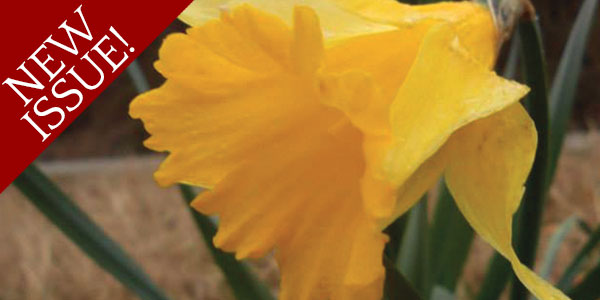

Wild Daffodils
by Ida Livingston of Davis City, IA
Living in the rolling hills of Tennessee, my family sat in the middle of prime timber country. This is fast evaporating with the widespread clearcutting. But in my teens, my siblings and I wandered all over the surrounding hills. Across the road from our farm was 2900 acres owned by an out-of-state investor. Behind us was another 800 acre tract bought remotely from an investor that the neighbors would never meet.
These tracts were hills and valleys that were densely wooded with oak, poplar, hickory and a spectrum of other eastern hardwoods. It was hard to imagine that there was ever anything but woodland in these places. Yet as my siblings and I, berry buckets in hand, scaled the hills and crossed the valleys, we would come upon abandoned homesites. Usually all that was left of these was the stone fireplace chimney and a carpet of daffodil greenery.
The daffodils spoke of not only a house in that place but a home had been there. A now faceless woman, had brightened a little corner of her wilderness with some relocated wild daffodils that remain long after she is gone. These flowers are toxic to anything mammal and cling tenaciously to life, not just living but thriving.
The Sawmill
My father bought an acreage that had one of these old homesites. There was no stone chimney. All that marked it was an old well, a leveled site, and the carpet of daffodils that burst into yellow in late February.
Unfortunately, this site was the best location on our property to put the small sawmill that my father had bought. The sawmill, a small log yard and lumber stacks soon covered the former homesite. In February, when the seasonal cues woke the daffodils from dormancy, they awoke to a new environment that was not conducive to their prosperity. But they tried to grow anyway! They sprung out in the busy walkways, where they were trampled. They’d lean out from under lumber stacks, try to grow through the sawdust piles, and crane their stems around a log to show the sun their faces.
Seeing this, I felt admiration and dismay. Armed with a shovel and wheelbarrow I began to transplant them. Knowing our own homesite did not have the space that thousands of daffodils would ask for, I considered my options.
Somewhere Along the Road
Deciding to share them with the world, I began planting the daffodils along the roadside. They bloom in late February in Tennessee and before the county mowers reclaimed roadside visibility in the summer, the daffodils would have died down for the year. They should be safe to grow there.
When they are growing and blooming in February is not the ideal time to transplant them, but it was the time of year that I could see where exactly the bulbs were. So I would dig them by the wheelbarrow load and transplant a cluster every couple feet along the road. Each February found more that I had missed as the log piles and lumberstacks migrated around the lot. A quarter of a mile in each direction came to be planted over the course of a few years.
Now all these years later, February finds a half mile of yellow along a remote road in Tennessee. Their simple immortal beauty lives on for future generations. They tell those passing by of a woman no longer there, who tried to brighten a little of her wilderness.





